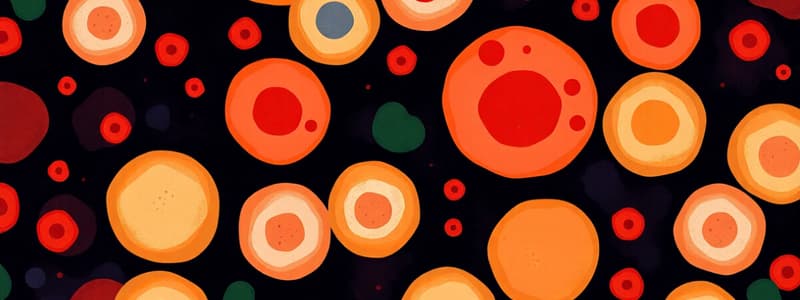Podcast
Questions and Answers
Which leukocyte type is characterized by a S-shaped nucleus and contains dark blue granules?
Which leukocyte type is characterized by a S-shaped nucleus and contains dark blue granules?
- Eosinophil
- Monocyte
- Basophil (correct)
- Lymphocyte
What is the primary development site for neutrophils?
What is the primary development site for neutrophils?
- Thymus
- Bone marrow (correct)
- Spleen
- Lymph nodes
Which leukocyte type is primarily involved in adaptive immunity and can be classified into B-cells and T-cells?
Which leukocyte type is primarily involved in adaptive immunity and can be classified into B-cells and T-cells?
- Neutrophil
- Eosinophil
- Monocyte
- Lymphocyte (correct)
Which type of leukocyte has a bi-lobed nucleus and is associated with combating parasitic infections?
Which type of leukocyte has a bi-lobed nucleus and is associated with combating parasitic infections?
What percentage of total leukocytes are neutrophils?
What percentage of total leukocytes are neutrophils?
What is the primary function of neutrophils in response to bacterial infections?
What is the primary function of neutrophils in response to bacterial infections?
Which characteristic is true regarding eosinophils?
Which characteristic is true regarding eosinophils?
What condition is characterized by an increased number of neutrophils?
What condition is characterized by an increased number of neutrophils?
Which disorder is specifically related to a defect in the myeloperoxidase system?
Which disorder is specifically related to a defect in the myeloperoxidase system?
In which type of reaction do basophils play a significant role?
In which type of reaction do basophils play a significant role?
What is the main function of T-lymphocytes in the immune response?
What is the main function of T-lymphocytes in the immune response?
Which of the following conditions is most likely to cause monocytosis?
Which of the following conditions is most likely to cause monocytosis?
What characterizes lymphocytosis?
What characterizes lymphocytosis?
Which of the following is NOT a characteristic of platelets?
Which of the following is NOT a characteristic of platelets?
What type of leukemia occurs in lymphoid tissue?
What type of leukemia occurs in lymphoid tissue?
Study Notes
Granulocytes vs. Agranulocytes
- Granulocytes are white blood cells that contain granules in their cytoplasm.
- Agranulocytes are white blood cells that lack granules in their cytoplasm.
- Granulocytes include neutrophils, eosinophils, and basophils.
- Agranulocytes include lymphocytes and monocytes.
Neutrophils
- Most abundant white blood cell (60-79% of circulating leukocytes).
- Multi-lobed nucleus (2-5 lobes).
- Fine granules in cytoplasm.
- Function: Kill bacteria through oxidative and non-oxidative mechanisms.
- Disorders: Neutrophilia (increase in neutrophil count) and neutropenia (decrease in neutrophil count).
Eosinophils
- Bi-lobed nucleus.
- Large, elongated, eosinophilic granules in cytoplasm.
- Function: Involved in killing parasitic worms and allergic reactions.
- Disorders: Eosinophilia (increase in eosinophil count).
Basophils
- Irregular bi-lobed nucleus.
- Large, basophilic granules in cytoplasm.
- Granule content: Histamine, Major basic protein.
- Function: Supplement mast cells in immediate hypersensitivity reactions and have a limited role in parasite response.
- Disorders: Basophilia (increase in basophil count).
Lymphocytes
- Spherical shape, dark round nucleus, condensed chromatin, thin rim of cytoplasm.
- 20-30% of circulating leukocytes.
- Function: B-cells produce antibodies (humoral immunity) and T-cells control other leukocytes, kill virus-infected cells, and cancer cells.
- Disorders: Lymphocytosis (increase in lymphocyte count).
Monocytes
- Oval, indented, or horseshoe-shaped nucleus.
- Blue-gray cytoplasm.
- Largest white blood cell.
- Function: Differentiate into macrophages in tissues, phagocytose parasites, viruses, cancer cells, and senescent cells.
- Disorders: Monocytosis (increase in monocyte count) and monocytopenia (decrease in monocyte count).
Leukemia
- Malignant neoplasms of leukocyte precursors.
- Can originate in lymphoid tissues or bone marrow.
- Characterized by the release of immature blood cells into circulation.
- Diagnosis: Bone marrow aspiration and immunohistochemistry.
- Treatment: Chemotherapy, radiotherapy, and bone marrow transplantation.
Platelets
- Non-nucleated, biconvex disc-like cell fragments.
- Derived from megakaryocytes.
- Function: Form blood clots through a series of steps including primary aggregation, secondary aggregation, blood coagulation, clot retraction, and clot removal.
- Disorders: Thrombocytopenia (decrease in platelet count), thrombocytosis (increase in platelet count), thrombasthenia (defective platelet function).
Complete Blood Count (CBC)
- Valuable clinical test used to screen and diagnose various medical conditions.
- Measures: Number of RBCs, WBCs, platelets, hemoglobin, hematocrit, and other blood indices.
Studying That Suits You
Use AI to generate personalized quizzes and flashcards to suit your learning preferences.
Related Documents
Description
Test your knowledge on the differences between granulocytes and agranulocytes, two essential types of white blood cells. This quiz covers their characteristics, functions, and disorders related to each type. Dive in to assess your understanding of these vital components of the immune system.




